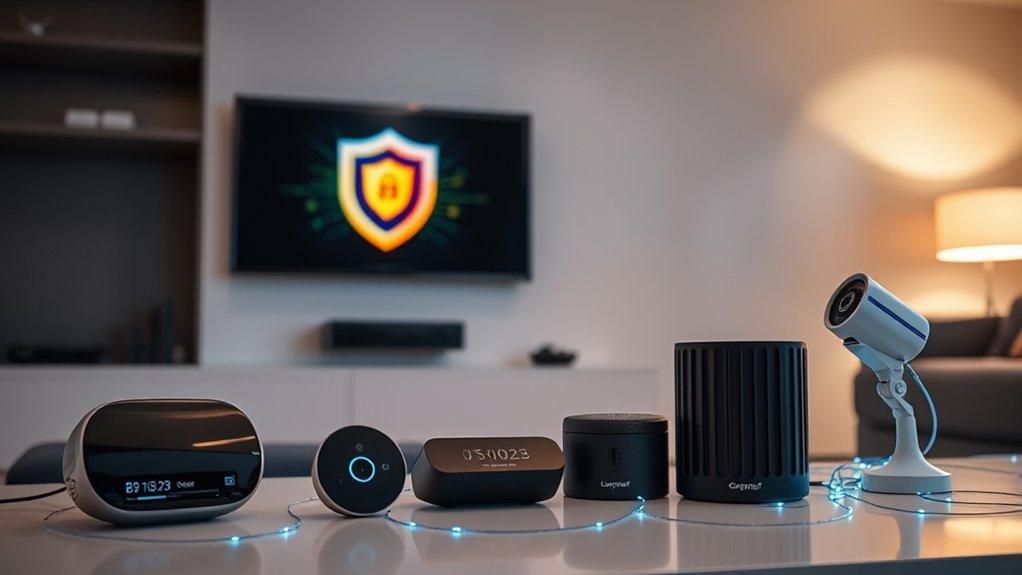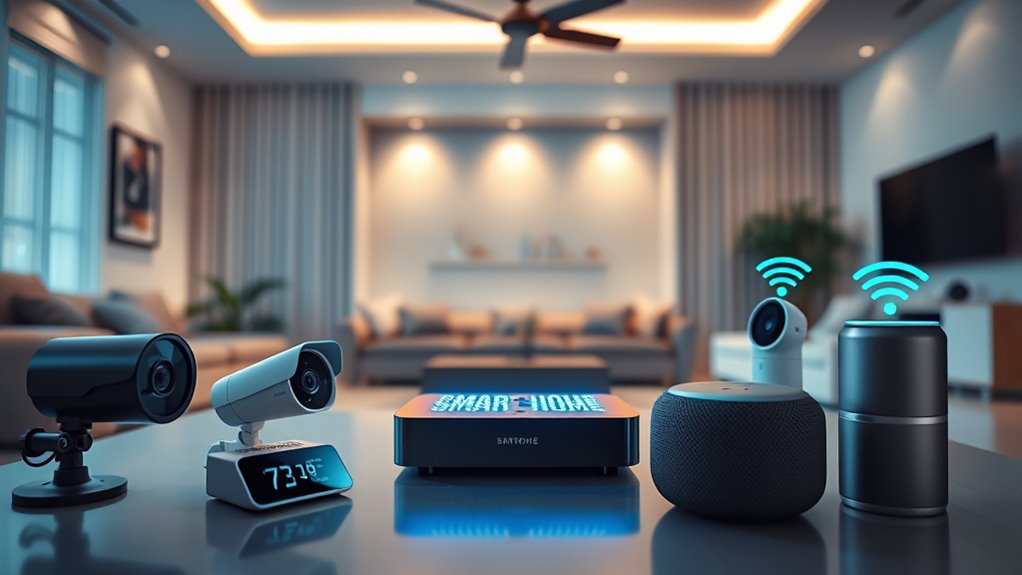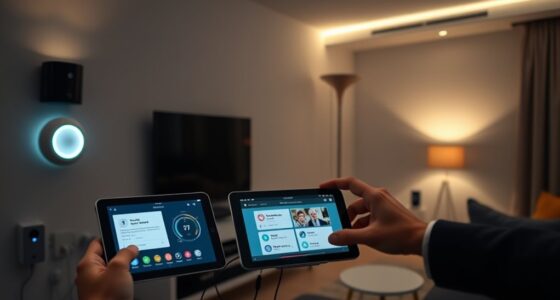To protect your smart devices from hackers, change default passwords to strong, unique ones, and regularly update your device firmware to patch security flaws. Secure your Wi-Fi with WPA3 encryption and avoid open networks. Disable remote access unless necessary, and enable firewalls or advanced router security features. Stay vigilant by monitoring devices for suspicious activity and avoiding phishing scams. Keep these steps in mind, and you’ll discover more ways to keep your smart home secure.
Key Takeaways
- Change default passwords to strong, unique ones and update device firmware regularly to fix security vulnerabilities.
- Secure your Wi-Fi with WPA3 encryption and set a strong password; consider creating a separate guest network.
- Disable remote access features unless necessary, and use VPNs or secure methods for remote device management.
- Implement firewalls and monitor your network for suspicious activity or unknown devices.
- Educate yourself on phishing, avoid malicious links, and verify updates to maintain ongoing device security.

In today’s connected world, securing your home online is more important than ever. With the proliferation of IoT devices—from smart thermostats to security cameras—you need to guarantee these devices are protected against cyber threats. IoT device security isn’t just about having the latest gadgets; it’s about making sure they don’t become entry points for hackers. Many devices come with default passwords or minimal security features, leaving your network vulnerable. To safeguard your smart home, start by changing default passwords to strong, unique ones. Regularly updating firmware is equally vital, as manufacturers often release patches that fix security flaws. These updates help close vulnerabilities that hackers could exploit to gain access to your devices.
Secure your smart home by changing default passwords and regularly updating device firmware to prevent cyber threats.
Another vital step is guaranteeing your Wi Fi network encryption is robust. Using WPA3 encryption, the latest standard, offers better security than previous versions. If your router only supports WPA2, consider upgrading it or enabling the highest encryption your device allows. Avoid using open or unsecured networks, especially when managing sensitive devices or data. Securing your Wi Fi network with a strong password prevents unauthorized access, making it harder for intruders to infiltrate your network and reach your connected devices. Setting up a separate guest network for visitors can also isolate your primary network, reducing the risk of malware spreading from unfamiliar devices.
Beyond encryption, consider implementing network security measures like firewalls or advanced security settings on your router. These tools can detect and block suspicious activity before it reaches your devices. Additionally, disable remote access features unless absolutely necessary. If remote control of your devices is essential, use VPNs or secure connections to access your network rather than exposing ports directly to the internet. Regularly monitor your network for unknown devices or unusual activity using your router’s management tools or third-party security apps. Staying vigilant is key to catching potential threats early.
Finally, educate yourself on the common tactics hackers use to target smart home devices. Phishing emails, fake updates, or malicious links can trick you into compromising your security. Always verify sources before clicking links or downloading updates, and avoid sharing sensitive network details. Incorporating trusted security certifications can also help ensure your devices meet high safety standards. By combining strong Wi Fi network encryption, vigilant IoT device security practices, and ongoing awareness, you create a formidable barrier against cyber threats. Protecting your smart home isn’t a one-time effort; it’s an ongoing process that keeps your devices, data, and family safe from hackers who are always looking for vulnerabilities to exploit.
Frequently Asked Questions
How Often Should I Update My Smart Device Firmware?
Your device update frequency is vital for keeping your smart devices secure and running smoothly. You should check for firmware updates at least once a month and follow your device’s firmware maintenance schedule. Regular updates patch security vulnerabilities and improve performance. Don’t wait for notifications—make it a habit to verify updates manually, ensuring your devices stay protected against hackers and function efficiently. Consistent firmware updates are essential for cybersecurity.
Can I Secure Devices Without Changing My Wi-Fi Password?
Think of your Wi-Fi as a fortress, where each room symbolizes a device. You don’t need to change your whole password to secure it. Instead, you can use Wi-Fi segmentation to create separate zones, and enable device encryption for added protection. These measures act like locks on each room, safeguarding your smart devices from intruders, without the hassle of altering your entire network’s password.
Are There Specific Brands More Vulnerable to Hacking?
Some brands are more vulnerable to hacking due to brand vulnerabilities and device reputation issues. You should research brand reputation before buying smart devices, as less reputable brands might lack robust security measures. High-profile brands often prioritize security, but no device is entirely immune. Always keep your device firmware updated and enable security features to protect yourself, regardless of the brand. Staying informed helps you choose safer options for your smart home.
What Should I Do if My Device Is Already Hacked?
If your device’s already hacked, act quickly to limit damage. First, isolate the device from your network to prevent the hacker from spreading. Next, perform hacker detection by running security scans or using trusted antivirus tools. Change all passwords linked to the device, and update its firmware or software to patch vulnerabilities. If issues persist, consider factory resetting the device or contacting support for further assistance.
Do Smart Home Security Systems Prevent All Cyber Threats?
Smart home security systems are like a sturdy fortress, but no system can guarantee absolute safety. They help by using device encryption and enforcing strong, unique default credentials, but savvy hackers can still find ways in. You need to stay vigilant—regular updates, strong passwords, and monitoring your devices are essential. Remember, even the best defenses can be breached if you don’t actively maintain your security practices.
Conclusion
Now that you know how to keep your smart devices secure, you’re better prepared to fend off hackers and protect your digital castle. Remember, just like a knight shields their fortress with a sturdy moat, you safeguard your home with strong passwords and updates. Don’t forget, in this digital age, staying vigilant is your best armor—think of it as your modern-day armor of shining pixels. Stay cybersafe, and your connected home will remain a sanctuary, not a battleground.









